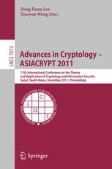Search
Search Results
-
Securing edge computing using cryptographic schemes: a review
The exponential growth and wide-area applications of the Internet of Things have garnered a lot of interest from academics and industries, thus...

-
Why you cannot even hope to use Gröbner bases in cryptography: an eternal golden braid of failures
In 1994, Moss Sweedler’s dog proposed a cryptosystem, known as Barkee’s Cryptosystem, and the related cryptanalysis. Its explicit aim was to dispel...
-
Polly Cracker, revisited
We formally treat cryptographic constructions based on the hardness of deciding ideal membership in multivariate polynomial rings. Of particular...

-
Homomorphic Encryption
Fully homomorphic encryption (FHE) has been called the “Swiss Army knife of cryptography”, since it provides a single tool that can be uniformly...
-
Creating Objects
Objects were a software experiment that worked. They were invented in the 1960s and in research labs in the 1970s. They became the new, mainstream...
-
A Fully Homomorphic Cryptosystem with Approximate Perfect Secrecy
We propose a new fully homomorphic cryptosystem called Symmetric Polly Cracker (SymPC) and we prove its security in the information theoretical...
-
Polly Cracker, Revisited, Revisited
In this paper, we consider the Polly Cracker with Noise (PCN) cryptosystem by Albrecht, Farshim, Faugère, and Perret (Asiacrypt 2011), which is a...
-
Practical Cryptanalysis of a Public-Key Encryption Scheme Based on New Multivariate Quadratic Assumptions
In this paper, we investigate the security of a public-key encryption scheme introduced by Huang, Liu and Yang (HLY) at PKC’12. This new scheme can...
-
Polly Cracker, Revisited
We initiate the formal treatment of cryptographic constructions (“Polly Cracker”) based on the hardness of computing remainders modulo an ideal over...
-
Multivariate Signature Scheme Using Quadratic Forms
Multivariate Public Key Cryptosystems (MPKC) are candidates for post-quantum cryptography. MPKC has an advantage in that its encryption and...
-
On the complexity of the BKW algorithm on LWE
This work presents a study of the complexity of the Blum–Kalai–Wasserman (BKW) algorithm when applied to the Learning with Errors (LWE) problem, by...

-
Crypto Galore!
I discuss three aspects of mathematical cryptography that have been themes of Mike Fellows’ work: applications of parameterized complexity,...
-
Reducing the Key Size of Rainbow Using Non-commutative Rings
Multivariate Public Key Cryptosystems (MPKC) are candidates for post-quantum cryptography. Rainbow is a digital signature scheme in MPKC, whose...
-
Lattice Signatures without Trapdoors
We provide an alternative method for constructing lattice-based digital signatures which does not use the “hash-and-sign” methodology of Gentry,...
-
A ciphertext-only attack on Polly Two
Polly Two is a public key encryption scheme that builds on the conceptual public key encryption scheme Polly Cracker. We describe a heuristic attack...
-
A Security Analysis of Uniformly-Layered Rainbow
In 1984, Ong, Schnorr and Shamir proposed an efficient signature scheme (OSS signature scheme) using a bivariate quadratic equation. Its security was...
-
Analysis of the MQQ Public Key Cryptosystem
MQQ is a multivariate public key cryptosystem (MPKC) based on multivariate quadratic quasigroups and a special transform called “Dobbertin...
-
Additively Homomorphic Encryption with d-Operand Multiplications
The search for encryption schemes that allow to evaluate functions (or circuits) over encrypted data has attracted a lot of attention since the...
-
Cryptanalysis of the TRMS Signature Scheme of PKC’05
In this paper, we investigate the security of the Tractable Rationale Maps Signature (TRMS) signature scheme [9] proposed at PKC’05. To do so, we...
-
Polly Two : A New Algebraic Polynomial-based Public-Key Scheme
Since Fellows and Koblitz introduced the generic combinatorially algebraic public-key cryptosystem Polly Cracker in 1993, the question whether there...
